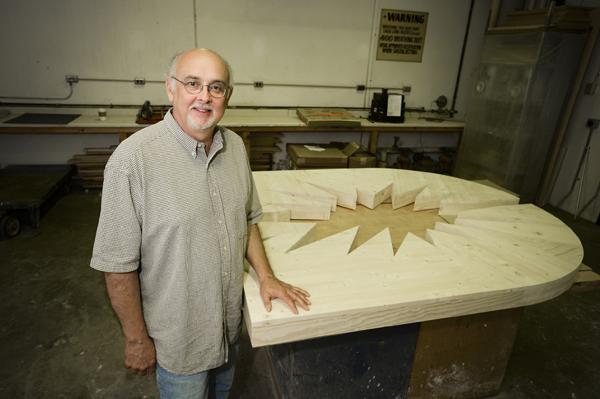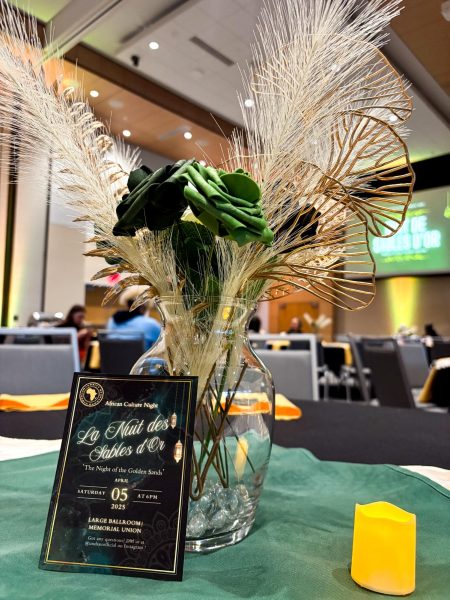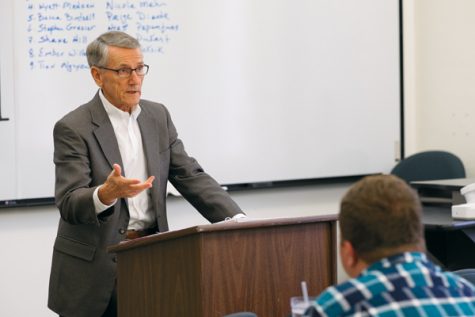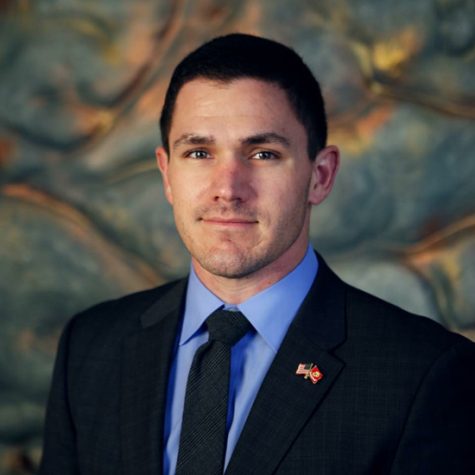The intersection of science and religion

Patrick Luber and his newest creation that displays the connection between science and religion. Photo by Jackie Lorentz
Patrick Luber, a professor of art at the University of North Dakota, has considered himself a sculptor for 35 years now.
“Sometimes I think I was one of those unusual kids,” Luber jokes. “But when I was in kindergarten, I already knew that I wanted to be an artist or an architect.”
Luber was recently awarded an Arts and Humanities Initiative Grant through the UND College of Arts & Sciences, which offers support to arts and humanities professors to encourage research. His winning proposal was to create a large-relief sculpture that blended both religion and science.
“People often think of these as opposing ideas,” Luber said. “But there’s also a number of people, including myself, who do not see them in opposition, but working together. Just because you believe in God and religion doesn’t mean you can’t believe in science, or vice versa.”
Believing that religion and the humanities intersect almost every facet of the human condition, Luber says that religion and science are not opposite ways of understanding the world. Instead, they simply provide answers to different questions. He also points out that creating a connection between religion and science is not a new idea, and that artists have been grappling with these questions for hundreds of years.
“There’s a lot of parallels between the way we talk about science and religion,” Luber said . “When science makes new discoveries, we often use words like wonder or awe, but we also use these same words when speaking about the divine. Many artists have tackled this subject and I guess I see myself as another in a long tradition of thinking about those relationships.”
Luber’s sculpture, which he expects to have completed in 2017, is more than 13 feet high and comes in 10 wooden components. When pieced together and hung on a wall, the components will have four inches of dispersion between them, creating a 14th or 15th-century altar-like composition.
In the center of the altar, Luber has created his interpretation of the Higgs Boson particle, a phenomenon of physics discovered at the Large Hadron Collider near Geneva, Switzerland. The Higgs Boson, commonly referred to as the “God particle,” is depicted as a large flash of light with striations shooting off in different directions over the altar.
Luber has also been toying with the idea of creating one or two small, glass-covered niches in his newest piece, complete with a long line of text along the bottom.
Once Luber decides the components are ready, he will then cover them with small sheets of aluminum he salvages from discarded pop cans. Slicing the cans into strips, he plans on nailing them over the wooden components in a specific pattern, which will reflect light at different angles, an approach he has used in several sculptures before.
Growing up on a farm, Luber was drawn to the idea of working with and manipulating materials. As he grew up, he learned to work with his hands and deal with the physical world around him. Combining his life lessons on the farm with his desire to create art, Luber attended college and took every art course he could. But it didn’t take long before a specific form of art grabbed his interest.
“I like the physicality of sculpting,” Luber said. “Sculptures walk that fine line between reality and illusion. With a painting, it may be very realistic and very well done, but usually you’re aware that it’s an illusion. When you have something tactile and three dimensional, it kind of exists a little bit in both of those worlds.”
Luber now teaches at UND while continuing to create new sculptures. Currently, he has works on display at three different shows in Minnesota, Idaho and Washington D.C. Luber, who earned his bachelor’s degree in at Greenville College in Illinois and his master’s degree in fine arts from the University of New Mexico, has been teaching in the UND Department of Art & Design since 1991.
Luber primarily specializes in relief sculptures, pieces that are frontally oriented and usually hang on a wall. While the sculptures project outward, they are never truly three-dimensional.
“I like working with relief sculpture partly because of how it’s related to architecture,” Luber said. “The wall where it’s hung becomes almost as much a part of the piece as the piece itself; it draws your attention to the fact that it is established or rooted in a place.”
Matt Eidson is the Opinion Editor of The Dakota Student. He can be reached at stewart.eidson@und.edu








